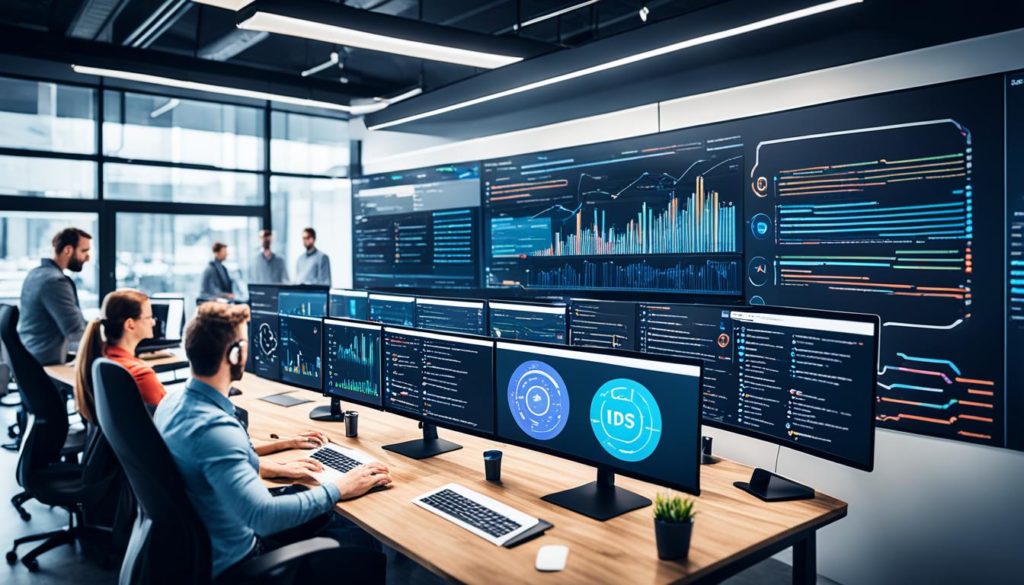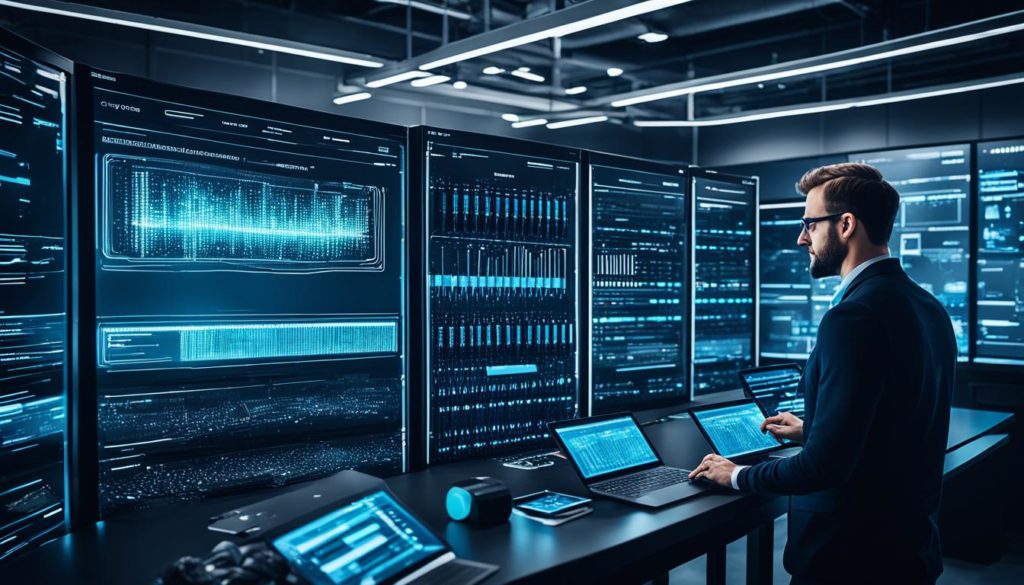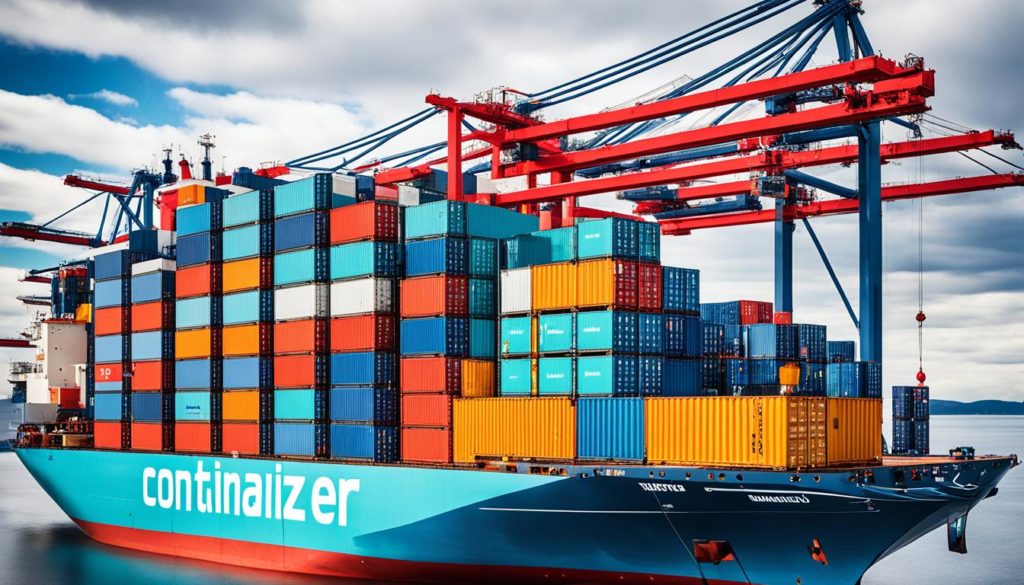
Did you know, as we move into 2023, industry leaders see it as a key year for backend development future trends? The digital era is making backend technologies crucial for creating robust digital platforms. As we demand more seamless and scalable digital services, the need for advanced backend solutions rises. This need is leading to a revolution with more agility and stronger security.
Today, spotting software development trends early is key. Serverless architectures bring a new approach, letting developers build applications without handling servers. Microservices and container computing add to this, boosting the need for better scalability and security. These changes show how much the industry is evolving.
Keeping up with new backend development skills and technologies is more important than ever. The demand for experts in cloud computing, distributed systems, and DevOps highlights where backend development is headed. It shows a move towards more advanced and managed backend solutions.
Key Takeaways
- The year 2023 stands out as pivotal for the ascension of new software development trends in backend development.
- Backend technologies are moving aggressively towards serverless architectures for their economy of scale and operational simplicity.
- Microservices and containerization are key for achieving the scalability and security necessary in today’s digital service offerings.
- Proficiency in cloud computing and DevOps is becoming more sought after as businesses seek to optimize their backend systems.
- The ongoing advancement of backend development skills is vital to stay current in a fast-evolving technological landscape.
Emerging Trends in Serverless Computing and its Impact on Backend Development
The world of advanced backend development is seeing big changes with serverless computing. This trend is changing how businesses use technology and develop software. Future-proof technologies are being combined with serverless to improve backend systems. This makes them more efficient and able to scale better.
What Is Serverless Computing?
Serverless computing, also known as Function as a Service (FaaS), lets developers build and run apps without handling servers. It reduces the need for system administration, making it easier for developers. This shift is key for modern advanced backend development.
How Serverless Computing Alters Backend Development
Serverless computing is changing backend architecture in big ways. Developers can now focus more on improving the product without worrying about servers. It works well with future-proof technologies. This ensures backend systems are not only efficient but also ready for future changes.
The Advantages of Serverless Architecture for Developers
A serverless approach saves money with its pay-as-you-go model. It lets businesses deal with more work without buying more servers. Also, it makes developing apps faster and brings products to the market quicker.
Serverless tech is used in API backends, data processing, and microservices. But, it can be hard to manage and debug at times. These challenges include sticking to one vendor and handling stateless functions and errors.
Companies like Netflix and AWS Lambda show how powerful serverless can be. They update quickly and handle large amounts of data well. This shows the value of serverless in today’s development world.
| Feature | Benefits | Challenges |
|---|---|---|
| Cost Efficiency | Only pay for the server space you use, reducing overhead costs significantly. | Potential for vendor lock-in, limited control over computing resources. |
| Scalability | Easily scales with demand without the need for manual intervention. | Managing and coordinating multiple serverless functions can be complex. |
| Developer Productivity | Developers can focus on writing code rather than managing servers. | Debugging and troubleshooting without traditional server logs can complicate issue resolution. |
Developers should explore serverless platforms to stay ahead in backend development. By adopting these methods, teams can enjoy the full benefits of this future-proof technology.
The Integration of AI and Machine Learning in Backend Systems
Today’s tech world is rapidly changing, thanks to the integration of AI and Machine Learning. These advances are completely transforming smart backend systems. They automate important parts of backend development, helping businesses move forward. With smoother operations, systems work better and more accurately.
AI and ML are key in making routine tasks automatic. This speeds things up and reduces mistakes, helping everything run smoothly. On top of making things automatic, AI and ML are great for managing and analyzing data. They quickly sift through big datasets, making it easier to make decisions and adapt apps.
- Predictive analytics by AI and ML help guess user behaviors. This optimizes resources and boosts app performance.
- By examining how users interact, AI and ML create personalized experiences. This keeps users happy and loyal.
- AI also plays a big part in security, quickly spotting possible threats. This keeps data safe and intact.
The automation in backend development also improves scalability and resource use. AI and ML predict app use trends, helping to allocate resources well. This not only meets current needs but also adjusts as demands grow.
As backends get smarter, AI and ML help anticipate problems before they happen. This makes systems proactive, not just reactive. Such backends constantly improve, staying top-notch and competitive in the fast-changing digital world.
Microservices: The Building Blocks of Modern Backend Architecture
In today’s fast-changing tech world, microservices architecture is changing how we see modern backend development. By breaking down large, complex apps into smaller, easier parts, this method boosts scalable backend systems. It also makes secure backend solutions stronger.
Definition and Advantages of Microservices
Microservices architecture brings a new way to manage big applications. It lets parts of websites or services work on their own. This cuts down on problems between different parts. The style makes for quicker development and fast updates. It works well with Continuous Integration/Continuous Deployment (CI/CD).
Comparing Monoliths and Microservices
Compared to old-style monoliths, microservices have many pluses. They scale better and are simpler to keep up. Monoliths are big programs where everything is connected. This makes changes hard. Microservices let you scale and manage parts by themselves. They respond faster to new demands.
Case Studies: Successful Implementations of Microservices
Many industries show how well microservices work. These examples show faster responses, better security, and more growth. They lead to happier customers and more business success.
| Company | Industry | Impact |
|---|---|---|
| Netflix | Streaming Services | Massive scalability, high availability |
| Amazon | E-commerce | Improved deployment times, better customer experience |
| Uber | Transportation | Enhanced flexibility, reduced downtime |
Containerization and Orchestration: Revolutionizing Backend Workflow
In our fast-changing tech world, containerization, through tools like Docker and Kubernetes, is key in reshaping backend workflows. This move to use containers shows a big change in creating, deploying, and growing applications.
Containerization is more than a trend; it boosts efficiency in development, testing, and production. By using containers, developers make sure the app works the same in every stage. This makes tasks like moving and deploying apps easier. Docker’s ease of use with different programming languages meets the need for quick changes and growth.
Containers weigh less than traditional virtual machines, which makes them more popular. They don’t need a whole OS like VMs do. Instead, containers use the host system’s kernel. This leads to quicker startups and better use of resources. Running containers in separate spaces also makes the system safer and handling dependencies simpler.
One great thing about containers is how well they work with orchestration, especially Kubernetes. Orchestration means automating tasks like deploying and managing containers. Kubernetes helps containers run smoothly and stay up, even with a heavy load, without needing constant checks.
Adding Docker Compose makes handling many containers at once much easier. It uses a YAML file to set up an application’s services, networks, and volumes. This means you can start everything with just one command, reducing mistakes. This way, applications can scale safely and support updates and growth in each part separately.
| Feature | Benefits |
|---|---|
| Lightweight Nature | Less overhead compared to VMs, faster startup times |
| Isolated Environment | Enhanced security, simplified dependency management |
| Scalability with Kubernetes | Automated scaling up or down as per demand |
| Docker Compose | Simplifies the setup of services via configuration files |
As backend development evolves, containerization and orchestration have a big impact. Tools like Docker and Kubernetes make the development process smoother and more secure. This isn’t just progress; it’s a revolution that’s underway.
Backend Development Future: Adapting to New Programming Paradigms
As we move through the changing world of backend development, staying up-to-date is key. With new frameworks and languages coming into play, we must adjust our tools and ways. Let’s dive into these exciting changes and how to be ready for them.
Exploring Programming Languages Forecast for Backends
Backend technology is advancing quickly, offering a bright future for languages like Go, Rust, and Python. Go is great for handling many tasks at once. Rust offers safety in memory usage, and Python is easy to use with Django for creating powerful apps. Having these languages is vital for building secure, efficient, and scalable apps, keeping us ahead in trends.
The Evolution of Backend Development Frameworks
Embracing new backend frameworks means more than just trying out new tools. It’s about seeing how they can make our work better and our products higher in quality. With Django, Flask, and Node.js, we can write code that’s easier to maintain. These frameworks help us adjust to changes in backend development. They lead the way in creating and expanding applications.
How Backend Developers Must Prepare for Future Challenges
To stay ahead of fast-moving tech in backend frameworks and languages, we must keep learning. Adopting a mindset ready for change allows us to use new languages and frameworks to their fullest. This proactive attitude puts us at the leading edge, ready to meet the tech world’s ever-changing challenges.
Conclusion
The future of backend development is exciting and full of potential. Innovation drives this field, as we see with new backend frameworks and technologies. As developers, we must master these tools. This lets us build systems that are strong, flexible, and meet the needs of our digital world. We’re moving towards using serverless computing, AI, and microservices architecture. This places us at the forefront of developing systems that are ready for the future.
We’re seeing trends that make backend technology crucial for creating secure, scalable, and modern applications. Adopting these new advancements is essential for leading in the digital arena. Innovative backend frameworks equip us to make our systems more efficient and responsive. They prepare us to face upcoming challenges.
Looking ahead, backend development is reaching for remarkable new heights. This is a thrilling moment for us to make an impact in this area. By improving our skills and adapting to these changes, our work will shape the foundation of digital applications and influence future user experiences. We’re committed to a future defined by innovation and breaking new ground in backend development.
FAQ
What are the emerging software development trends shaping the backend development future?
Several trends are transforming backend development. These include serverless computing, AI and machine learning, microservices, and containerization. Developers are adopting these technologies. They create scalable, secure, and efficient systems.
What Is Serverless Computing?
Serverless computing is a way to use the cloud where the provider handles machine resources. Developers focus on their code. They don’t worry about servers. This makes scaling easy and reduces the need to manage systems.
How Serverless Computing Alters Backend Development?
Serverless computing changes backend development by removing server management tasks. It cuts costs and boosts scalability. The development process is smoother and can quickly adjust to new demands. This makes backend systems more future-proof.
What are the Advantages of Serverless Architecture for Developers?
Serverless architecture has many benefits. It lowers operational costs and increases scalability. Developers can push updates quickly. They can also use cloud capabilities for better backend development. This leads to faster release of features and updates.
How are AI and Machine Learning impacting backend systems?
AI and machine learning are making backend systems smarter. They automate tasks, personalize experiences, and manage data well. These systems predict user behavior. They optimize operations automatically. This improves backend development automation.
What are Microservices and their advantages in backend development?
Microservices split applications into small, independent services. They offer modularity and scalability. Deployment and fault isolation get better. These benefits are crucial for secure and modern backend solutions.
How do Monoliths and Microservices architectures compare?
Monolithic architectures combine all parts of an app in one codebase. Microservices divide functionalities into smaller services. These services can be independently developed and scaled. Microservices are more agile and resilient than monolithic systems.
Can you provide Case Studies of successful implementations of Microservices?
Companies like Netflix, Amazon, and eBay switched to microservices. They handle large, complex systems better now. Their systems are scalable and easier to maintain and update.
How is Containerization shaping backend development?
Containerization uses tools like Docker to package an app’s code, configurations, and dependencies. This ensures consistent environments throughout development. It simplifies deployments and application management. Containerization drives backend development evolution.
What programming languages are predicted to lead backend development into the future?
Languages like Go and Rust are leading the way. Go is simple yet efficient. Rust focuses on safety and concurrency. Both are becoming popular for backend development.
How are Backend Development Frameworks evolving?
Backend frameworks are adapting to meet new demands. Django, for example, incorporates features for complex app development. The trend is towards frameworks that enable quick, scalable, and secure development.
How must Backend Developers prepare for future challenges?
Backend developers should keep up with new technologies and trends. They need to understand new programming methods and adapt to the changing landscape. Continual learning and flexibility are essential. This helps leverage new tools and practices effectively.
Future App Studios is an award-winning software development & outsourcing company. Our team of experts is ready to craft the solution your company needs.










